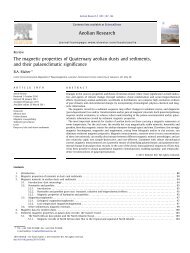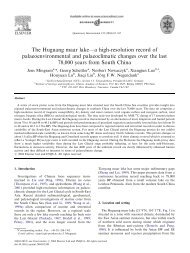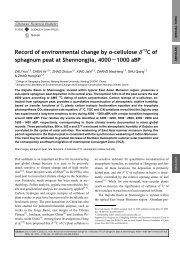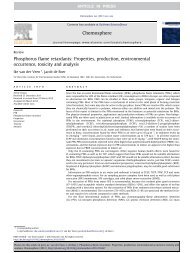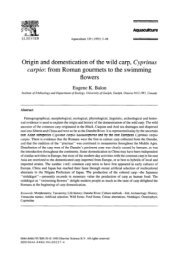Mono- and dicyclic unsaturated triterpenoid hydrocarbons in ...
Mono- and dicyclic unsaturated triterpenoid hydrocarbons in ...
Mono- and dicyclic unsaturated triterpenoid hydrocarbons in ...
You also want an ePaper? Increase the reach of your titles
YUMPU automatically turns print PDFs into web optimized ePapers that Google loves.
886 R. de Mesmay et al. / Organic Geochemistry 39 (2008) 879–893<br />
relative <strong>in</strong>tensity<br />
%<br />
100<br />
50<br />
0<br />
%<br />
100<br />
50<br />
0<br />
%<br />
100<br />
50<br />
0<br />
43<br />
57<br />
69<br />
86<br />
A<br />
relative <strong>in</strong>tensity<br />
O1<br />
O4<br />
O<br />
H<br />
113<br />
109 123<br />
O4 O5<br />
O2 O3<br />
40 60 80 100 120 140 160 180 200 220 240 m/z<br />
43<br />
55 71<br />
83<br />
95<br />
100<br />
113<br />
O7<br />
127<br />
141<br />
465) twice more <strong>in</strong>tense than the similar ion <strong>in</strong> the spectrum<br />
of e (35% <strong>in</strong>stead of 16%), suggest<strong>in</strong>g that more than<br />
one ethyl group occurs <strong>in</strong> j. Unfortunately, GC-MS analysis<br />
of the ozonolysis products did not allow identification of<br />
the compound result<strong>in</strong>g from the cleavage of the right half<br />
part of the molecule, likely due to coelution with triphenyl<br />
+H<br />
O6 O7 O8<br />
18 20 22 24 26 time (m<strong>in</strong>.)<br />
B C<br />
113<br />
226<br />
141<br />
141<br />
151 168 179 197<br />
O<br />
H<br />
155<br />
161<br />
240<br />
O<br />
57<br />
226<br />
236<br />
M +.<br />
254<br />
D E<br />
184<br />
225<br />
207<br />
197 240 M<br />
250<br />
+. -H2O 40 60 80 100 120 140 160 180 200 220 240 260 m/z<br />
55<br />
O10<br />
H<br />
O<br />
+H<br />
113<br />
+H<br />
113<br />
O<br />
184<br />
155<br />
225<br />
O<br />
+H 71<br />
100<br />
F G<br />
43<br />
69<br />
40 60 80 100 120 140 160 180 200 220 240 260 m/z<br />
85<br />
95 141<br />
123<br />
113<br />
151<br />
169<br />
267<br />
198 226<br />
253 M<br />
282<br />
+.<br />
+H +H<br />
+H<br />
86<br />
254 198<br />
141 141 254<br />
156<br />
M +. -CH3 M +. -C2H5 O<br />
+H<br />
169<br />
127<br />
156<br />
+H<br />
86<br />
+H<br />
21<br />
86<br />
O<br />
H<br />
43<br />
%<br />
100<br />
50<br />
0<br />
O9<br />
43<br />
55<br />
55<br />
71<br />
83<br />
O10<br />
100<br />
O11<br />
O5<br />
M +.<br />
109<br />
123<br />
179<br />
240<br />
137 155168 189 207 225 250 268<br />
113<br />
40 60 80 100 120 140 160 180 200 220 240 260 280<br />
43<br />
83<br />
127<br />
95<br />
109<br />
H<br />
O9<br />
H<br />
O<br />
+H<br />
156<br />
155<br />
141<br />
167<br />
M<br />
253<br />
184 212 240<br />
+. M -CH3 250<br />
+. -H2O M +.<br />
268<br />
40 60 80 100 120 140 160 180 200 220 240 260 m/z<br />
43<br />
55<br />
71<br />
72<br />
84<br />
95<br />
113<br />
109 127<br />
O11<br />
O<br />
phosph<strong>in</strong>e, the reagent used for the reduction of the polyozonides.<br />
However, taken with these mass spectral data,<br />
the strong structural relationship between the C34-C35 masokocenes<br />
<strong>and</strong> the C 36 analogue allows us to assign compound<br />
j as a C36 <strong>dicyclic</strong> botryococcene with two gem<strong>in</strong>al<br />
ethyls on carbon C-21.<br />
O<br />
113<br />
240<br />
113<br />
O<br />
155<br />
155<br />
225<br />
156<br />
+H<br />
O<br />
71<br />
+H<br />
100<br />
+H<br />
72<br />
O<br />
H<br />
+H +H<br />
240 184<br />
141 127<br />
+H<br />
240<br />
72<br />
H<br />
184<br />
+H +H<br />
+H<br />
H<br />
O<br />
141 197<br />
72<br />
137<br />
155<br />
169<br />
184<br />
222<br />
M<br />
281<br />
250<br />
40 60 80 100 120 140 160 180 200 220 240 260 m/z<br />
+. -CH3 296<br />
M+.<br />
Fig. 6. (A) Total ion chromatogram of ozonised hydrocarbon fraction from Lake Masoko sediment at 1856–1871 cm depth. (B-G) EI mass spectra of<br />
compounds O4, O5, O7, O9, O10 <strong>and</strong> O11.<br />
%<br />
100<br />
50<br />
0<br />
%<br />
100<br />
50<br />
0<br />
O<br />
127<br />
155<br />
H<br />
197<br />
-H<br />
141<br />
O<br />
84<br />
43



